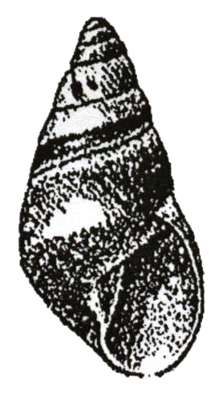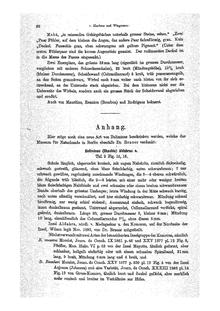Aldabra snail
| Aldabra snail | ||||||||||||
|---|---|---|---|---|---|---|---|---|---|---|---|---|

Illustration of a case of Rhachistia aldabrae in the first description in 1898 |
||||||||||||
| Systematics | ||||||||||||
|
||||||||||||
| Scientific name | ||||||||||||
| Rhachistia aldabrae | ||||||||||||
| from Martens , 1898 |
The Aldabra snail ( Rhachistia aldabrae ) is a land-living snail from the suborder of the land snail (Stylommatophora). She is on the the Republic of Seychelles belonging Aldabra - Atoll home. After no living specimens of the species had been found since 1997, it was considered to be extinct in 2007 with "95 percent probability". In August 2014, several live Aldabra snails, including juveniles, were discovered by a team from the Seychelles Islands Foundation on the island of Malabar (Middle Island), located on the northwest corner of the atoll .
features
The housing is elongated, rounded, conical and thick-shelled. Its length is about 2 cm. The snail has seven slightly arched turns, the diameter of which increases steadily towards the mouth. The mouth is narrow pear-shaped, only slightly crooked. The last turn is brown below the largest circumference, above a broad or two narrower black-brown bands can be seen. The last two to three turns of the seam bandage are pink to purple. The upper turns are blackish to dark purple in color, towards the middle indigo or "cloudy bluish" as Eduard von Martens describes.
distribution
The Aldabra banded snail is on the Republic of Seychelles belonging Aldabra Atoll endemic . It was to be found regularly on the islands of Picard , Malabar, Polymnie , Esprit and Grande Terre, which belong to the atoll, until 1976 . It was even very common on Grande Terre at the beginning of the 20th century. After 1976 only two specimens were discovered, in 1986 and 1997 on the island of Picard. It was not until August 2014 that an inventory of some seldom visited parts of the island of Malabar could be observed again adult and juvenile animals.
Way of life
Little is known about the way of life and ecological demands of the Aldabra snails. Accordingly, it was only possible to speculate about the causes of the decline in populations. Since Aldabra was added to the UNESCO World Heritage List in 1982 and is under strict nature protection, there is no threat from deforestation or settlement. A connection with the increasing lack of precipitation on the atoll due to climate change and the resulting long dry periods on the islands was assumed.
After finding several Aldabra snails on the island of Malabar, investigations into the behavior and nutrition of the snails can be carried out. They live on bushes and in mixed vegetation near the coast, so that it is assumed that they have no special requirements for the flora of their habitat . Related species of the genus Rhachistia on nearby islands or on the African and Asian mainland graze the algae lawn on plants. They have a relatively high progeny and live for several years. It is assumed that the Aldabra snail was able to survive the dry periods because of its ultimately small size in moist hollows and crevices.
Systematics and taxonomy
Rhachistia aldabrae was first described in 1898 by Eduard von Martens as Bulimius (Rhachis) Aldabrae . The first description in the communications from the zoological collection of the Museum für Naturkunde in Berlin was based on a case that August Brauer brought with him from his trip to the Seychelles between 1894 and 1895.
Individual evidence
- ↑ a b c J. Gerlach: Short-term climate change and the extinction of the snail Rhachistia aldabrae (Gastropoda: Pulmonata). Biology Letters, 3, 5, pp. 581-584, Royal Society, 2007 PDF doi : 10.1098 / rsbl.2007.0316
- ^ Extinct snail re-discovered at Aldabra Atoll . Seychelles Island Foundation, 2014
- ^ A b Eduard von Martens & Carl Arend Friedrich Wiegmann: Land and freshwater mollusks of the Seychelles according to the collections of Dr. Aug. Brewer. Messages from the zoological collection of the Museum für Naturkunde in Berlin, 1, pp. 1–94, 1898, p. 28 (first description)
- ^ M. Smith: The land Mollusca on Aldabra . The Nautilus, 23, 5, pp. 69-70, October 2009 facsimile
- ^ AC van Brugge: Streptaxidae from Aldabra Island, Western Indian Ocean . Bulletin of the British Museum (Natural History), 28, 5, pp. 157-175, September 17, 1975 Facsimile, p. 171
- ^ A b Extinct snail re-discovered in Seychelles. IUCN News of September 5, 2014, accessed September 17, 2014
literature
- Eduard von Martens & Carl Arend Friedrich Wiegmann : Land and freshwater molluscs of the Seychelles according to the collections of Dr. Aug. Brewer. Messages from the zoological collection of the Museum für Naturkunde in Berlin, 1, pp. 1–94, 1898, p. 28 (first description)
Web links
- Snail species extinct: to blame for climate change? Science ORF online from August 1, 2007, accessed on September 17, 2014
- Extinct snail re-discovered in Seychelles . IUCN News of September 5, 2014, accessed September 17, 2014
- Seychelles snail, thought extinct due to climate change, still alive ( Memento from September 9, 2014 in the Internet Archive ). The Detroit News, September 8, 2014, accessed September 17, 2014
- Rhachistia aldabrae inthe IUCN Red List of Threatened Species 2014.3. Posted by: Gerlach, J., 2006. Retrieved February 24, 2015.
